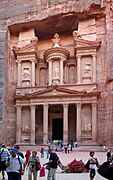Rock-cut tomb
A rock-cut tomb or kokh is a burial chamber that is cut into the living rock usually along the side of a hill. It was a common form of burial for the wealthy in ancient times in several parts of the world.
Important examples are found in Egypt, most notably in the town of Deir el-Medina (Seet Maat) which is located between the Valley of the Kings and the Valley of the Queens.[1]
Other notable clusters include numerous rock-cut tombs in modern Israel, at Myra in Turkey, Petra in modern Jordan, Mada'in Saleh in Saudi Arabia and Larnaca.[2]
-

Rock-cut tombs in Myra.
-
Al Khazneh or the Treasury at Petra.
-
Qasr al Farid, tomb in Archeological site Mada'in Saleh, Al-`Ula, Saudi Arabia
Kokh
A kokh (plural: kokhim, Hebrew: כּוּךְ) is a type of tomb complex characterized by a series of long narrow shafts, in which the deceased were placed for burial, radiating from a central chamber. These tomb complexes were generally carved into a rock face, and were usually closed with a stone slab and had channels cut into the centre of the shaft to drain any water that seeped through the rock.
A kokhim complex survives at the far west end of the Church of the Holy Sepulchre in Jerusalem. The Church wall runs through the centre of the complex, and the remaining two thirds no longer exist [sic!]. Many more kokhim can be found throughout the Judean foothills.
See also
References
- ↑ Dodson, Aidan (1991). Egyptian Rock-cut Tombs. Buckinghamshire: Shire Publications Ltd. ISBN 0-7478-0128-2.
- ↑ Hadjisavvas, Sophocles (2012). The Phoenician Period Necropolis of Kition, Volume I. Shelby White and Leon Levy Program for Archaeological Publications. p. 1.



